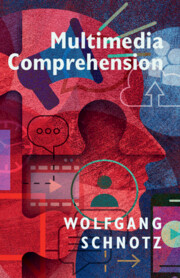Book contents
- Multimedia Comprehension
- Multimedia Comprehension
- Copyright page
- Dedication
- Contents
- Preface
- Chapter 1 Introduction
- Chapter 2 A Short History of Multimedia Sign Systems
- Chapter 3 Basic Forms of Representations
- Chapter 4 Comprehension of Text
- Chapter 5 Comprehension of Pictures
- Chapter 6 Integrative Comprehension of Texts and Pictures
- Chapter 7 Quasi-symbiotic Relations between Text and Picture Comprehension
- Chapter 8 Beyond Comprehension
- Chapter 9 Practical Implications
- Concluding Remarks
- References
- Index
Chapter 1 - Introduction
Published online by Cambridge University Press: 16 February 2023
- Multimedia Comprehension
- Multimedia Comprehension
- Copyright page
- Dedication
- Contents
- Preface
- Chapter 1 Introduction
- Chapter 2 A Short History of Multimedia Sign Systems
- Chapter 3 Basic Forms of Representations
- Chapter 4 Comprehension of Text
- Chapter 5 Comprehension of Pictures
- Chapter 6 Integrative Comprehension of Texts and Pictures
- Chapter 7 Quasi-symbiotic Relations between Text and Picture Comprehension
- Chapter 8 Beyond Comprehension
- Chapter 9 Practical Implications
- Concluding Remarks
- References
- Index
Summary
This chapter aims at clarifying basic concepts related to multimedia: communication, comprehension, and learning. Multimedia communication is considered as the intentional creation, display, and reception of multiple kinds of signs in order to convey messages about some content. It entails two subprocesses: meaning and comprehension. Multimedia meaning is a process in which the producer of a message creates multiple external signs based on his or her prior knowledge in order to direct the recipient’s mind so that the recipient understands what the producer means. Multimedia comprehension is the complementary process of reconstructing the previously externalized knowledge in the mind of the recipient. It can be seen as the bottleneck of multimedia communication. Multimedia comprehension and multimedia learning are related but are nevertheless different: While multimedia comprehension results in transient changes in working memory, multimedia learning results in permanent changes in long-term memory. Multimedia learning is a byproduct of multimedia comprehension. Further, an overview of the book is presented.
Keywords
Information
- Type
- Chapter
- Information
- Multimedia Comprehension , pp. 1 - 12Publisher: Cambridge University PressPrint publication year: 2023
